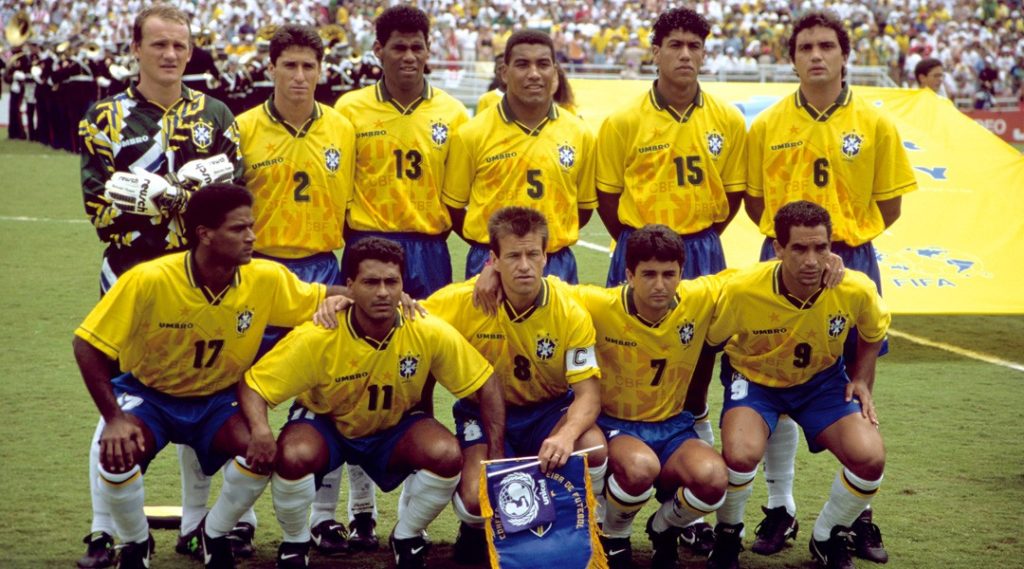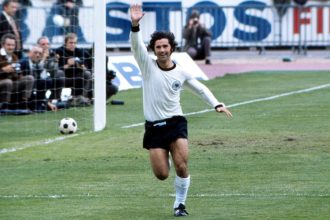The FIFA World Cup is undoubtedly one of the most anticipated and celebrated events in the world of sports. Among its illustrious history, the 1994 World Cup holds a special place. Hosted by the United States, this tournament left an indelible mark on football enthusiasts worldwide. Let’s take a journey back in time and revisit the highlights of the 1994 World Cup.
The United States was chosen as the host nation, signifying a significant milestone for soccer in a country where it had previously struggled to gain popularity. Excitement soared as the American public embraced the tournament, creating an unprecedented surge in soccer fever across the nation.

Teams:
Belgium, Bulgaria, Germany, Greece, Italy, Netherlands, Norway, Republic of Ireland, Romania, Russia, Spain, Sweden, Switzerland, Mexico, United States (hosts), Argentina, Brazil, Bolivia, Colombia, Saudi Arabia, South Korea, Cameroon, Morocco, and Nigeria.
The official mascot of this World Cup was “Striker, the World Cup Pup”, a dog wearing a red, white, and blue soccer uniform with a ball. Striker was designed by the Warner Bros. animation team. A dog was picked as the mascot because dogs are a common pet in the United States

The format of the competition stayed the same as in the 1990 World Cup: 24 teams qualified, divided into six groups of four. Sixteen teams would qualify for the knockout phase: the six group winners, the six group runners-up, and the four third-placed teams with the best records. This was the last time this format was used, due to the expansion of the finals tournament in 1998 to 32 teams. FIFA introduced three rule changes for this tournament to encourage attacking play: three points awarded for a win in a group stage match instead of two, a relaxed offside rule, and a ban on picking up back passes to goalkeepers. The number of goals increased to 2.73 per game from the record-low of 2.21 in 1990.



The opening ceremony of the World Cup was held on June 17 at Chicago’s Soldier Field. The ceremony was emceed by Oprah Winfrey, who introduced Diana Ross, who gave a musical performance. Ross was also supposed to kick a soccer ball into the goal from the penalty spot at the beginning of her performance, with the goal then splitting in two as part of a pre-orchestrated stunt. She kicked the ball wide to the left, missing the goal, but the goalposts collapsed anyway in accordance with the stunt plans. In addition, Daryl Hall and Jon Secada also gave musical performances. It was officially opened by then-President Bill Clinton.

The 1994 World Cup showcased thrilling matches and breathtaking displays of skill. The tournament kicked off with a high-scoring encounter between Germany and Bolivia, setting the tone for a goal-filled spectacle. Legendary players like Romário (Brazil), Roberto Baggio (Italy), Hristo Stoichkov (Bulgaria), and Bebeto (Brazil) left an indelible mark with their dazzling performances.


Brazil’s win over the hosts helped take them to the final against Italy. Brazil’s path was relatively smooth as they never trailed over 270 minutes of the knockout stage, defeating the Netherlands in the quarter-finals and Sweden in the semis after the aforementioned win over the hosts. The Italians meanwhile had made hard work of reaching the final. During the group stage, Italy struggled and narrowly advanced to the next round, despite losing 1–0 to the Republic of Ireland. Italian playmaker Roberto Baggio, who as the reigning FIFA World Player of the Year and Ballon D’Or holder, was expected[by whom?] to be one of the stars of the tournament,[citation needed] had not yet scored a goal. During the Round of 16 games against Nigeria, Italy was trailing 1–0 in the dying minutes when Baggio scored the tying goal, forcing the game into extra time. He scored again with a penalty kick to send Italy through. Baggio carried the Italians from there, scoring the game-winning goal in the quarter-final against Spain, and both goals in Italy’s semi-final victory over Bulgaria.
The third-place playoff was set between Bulgaria and Sweden, the team which scored more goals than any other in this World Cup with 15 over seven matches. These teams had also previously met in the qualifying group. Sweden won, 4–0. Swedish forward Tomas Brolin was named to the All-Star team.

The final game at the Rose Bowl was tense but devoid of scoring chances. It was the second time in 24 years that the two nations had met in a final. After 120 goalless minutes, the World Cup was decided for the first time by a penalty shoot-out. After four rounds, Brazil led 3–2, and Baggio, playing injured, had to score to keep Italy’s hopes alive. He missed by shooting it over the crossbar, and the Brazilians were crowned champions for the fourth time. After the game ended, Vice President Al Gore hosted the awarding ceremony by handing Brazilian captain Dunga the prestigious trophy; the Brazil national team dedicated the title to the deceased Formula One motor racing champion and countryman Ayrton Senna, who had died two and a half months prior.




The tournament’s Golden Boot went jointly to Bulgaria’s Stoichkov and Oleg Salenko of Russia, the latter becoming the first player to score five goals in a game, coming in a 6–1 victory against Cameroon. Both players scored six goals in the tournament. Brazilian striker Romário, with five goals, won the Golden Ball as the tournament’s best player.


Despite the controversy, the U.S. staged a hugely successful tournament, with an average attendance of nearly 70,000, surpassing the 1966 FIFA World Cup average attendance of 51,000, thanks to the large seating capacities of the stadiums in the United States in comparison to the generally smaller venues of Europe and Latin America. To this day, the total attendance for the final tournament of nearly 3.6 million remains the highest in World Cup history, despite the expansion of the competition from 24 to 32 teams at the 1998 World Cup in France.
The 1994 World Cup celebrated the rich tapestry of cultures that make up the global football community. The tournament became a melting pot of traditions, as fans from all corners of the globe united to support their favorite teams. The colorful displays, passionate chants, and joyous celebrations added an extra layer of excitement to the matches, leaving an enduring impression on both players and spectators.
The 1994 World Cup left a lasting legacy, particularly in the United States. The tournament’s success sparked a surge in soccer’s popularity, leading to the establishment of Major League Soccer (MLS) in 1996. The foundations laid during this World Cup paved the way for the growth of the sport, inspiring a new generation of American players and fans.





